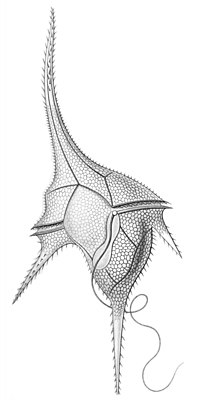
Photocatalytic inactivation and destruction of harmful microalgae Karenia mikimotoi under visible-light irradiation: Insights into physiological response and toxicity assessment.
Sign Up to like & getrecommendations! Published in 2021 at "Environmental research"
DOI: 10.1016/j.envres.2021.111295
Abstract: Harmful algal blooms (HABs) caused by Karenia mikimotoi have frequently happened in coastal waters worldwide, causing serious damages to marine ecosystems and economic losses. Photocatalysis has potential to in-situ inhibit algal growth using sustainable sunlight.… read more here.
Keywords: visible light; karenia mikimotoi; toxicity; inactivation ... See more keywords

Allelopathic interactions between the macroalga Hizikia fusiformis (Harvey) and the harmful blooms-forming dinoflagellate Karenia mikimotoi.
Sign Up to like & getrecommendations! Published in 2017 at "Harmful algae"
DOI: 10.1016/j.hal.2017.04.003
Abstract: The effects of algal blooms on seaweeds have been rarely studied, although harmful algal blooms (HABs) are now normally regarded as worldwide incidents. In the present study, the effects of dense Karenia mikimotoi cells on… read more here.
Keywords: hizikia fusiformis; fusiformis; mono cultured; karenia mikimotoi ... See more keywords

Cell density-dependent suppression on the development and photosynthetic activities of Sargassum fusiformis embryos by dinoflagellate Karenia mikimotoi.
Sign Up to like & getrecommendations! Published in 2020 at "Harmful algae"
DOI: 10.1016/j.hal.2020.101842
Abstract: Lots of research has demonstrated that macroalgae can strongly inhibit the growth of harmful algal bloom (HAB) species in general. However, the effects of HABs or HAB-forming species on macrophytes are still largely uncharacterized until… read more here.
Keywords: suppression; embryos; photosynthetic activities; mikimotoi ... See more keywords

Application of clay minerals to remove extracellular ichthyotoxins produced by the dinoflagellates Karlodinium veneficum and Karenia mikimotoi.
Sign Up to like & getrecommendations! Published in 2022 at "Harmful algae"
DOI: 10.1016/j.hal.2021.102151
Abstract: Mitigation of fish-killing algal toxins by clay minerals offers great promise as an emergency strategy for fish farms threatened by harmful algal blooms, but its efficiency is highly clay and algal species (i.e. ichthyotoxin) specific.… read more here.
Keywords: karlodinium veneficum; veneficum karenia; mikimotoi; clay minerals ... See more keywords

Size-dependent oxidative stress effect of nano/micro-scaled polystyrene on Karenia mikimotoi.
Sign Up to like & getrecommendations! Published in 2020 at "Marine pollution bulletin"
DOI: 10.1016/j.marpolbul.2020.111074
Abstract: The effects of polystyrene (PS) of different sizes of diameter (65 nm, 100 nm and 1 μm) with different treat concentrations (control, 1 mg L-1 and 10 mg L-1) on growth and oxidative stress for K. mikimotoi were assessed across PS short-term… read more here.
Keywords: mgprot; size; nano micro; mikimotoi ... See more keywords

Nutrient Alteration Drives the Impacts of Seawater Acidification on the Bloom-Forming Dinoflagellate Karenia mikimotoi
Sign Up to like & getrecommendations! Published in 2021 at "Frontiers in Plant Science"
DOI: 10.3389/fpls.2021.739159
Abstract: Seawater acidification and nutrient alteration are two dominant environmental factors in coastal environments that influence the dynamics and succession of marine microalgae. However, the impacts of their combination have seldom been recorded. A simulated experimental… read more here.
Keywords: seawater acidification; acidification; alteration; bloom ... See more keywords

Assessing the Effect of Modified Clay on the Toxicity of Karenia mikimotoi Using Marine Medaka (Oryzias melastigma) as a Model Organism
Sign Up to like & getrecommendations! Published in 2022 at "Toxics"
DOI: 10.3390/toxics10030105
Abstract: Blooms of the toxic dinoflagellate Karenia mikimotoi could threaten the survival of marine life, and modified clay (MC) is considered a promising method for the control of harmful algal blooms. Here, using marine medaka as… read more here.
Keywords: using marine; mikimotoi; modified clay; toxicity ... See more keywords

The Bloom-Forming Dinoflagellate Karenia mikimotoi Adopts Different Growth Modes When Exposed to Short or Long Period of Seawater Acidification
Sign Up to like & getrecommendations! Published in 2021 at "Toxins"
DOI: 10.3390/toxins13090629
Abstract: Impacts of ocean acidification (OA) on noncalcifying organisms and the possibly responsible mechanism have aroused great research interests with the intensification of global warming. The present study focused on a noxious, noncalcifying, bloom-forming dinoflagellate, Karenia… read more here.
Keywords: seawater acidification; acidification; bloom forming; mikimotoi ... See more keywords